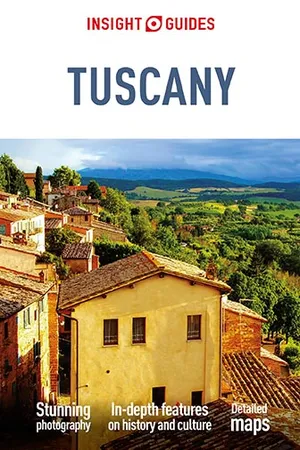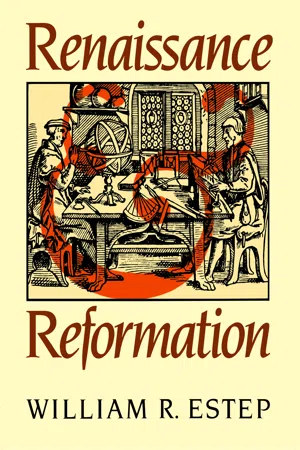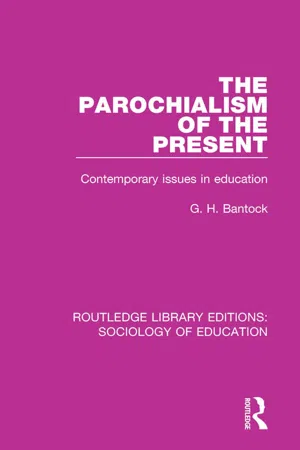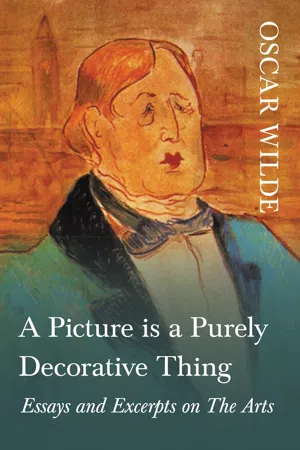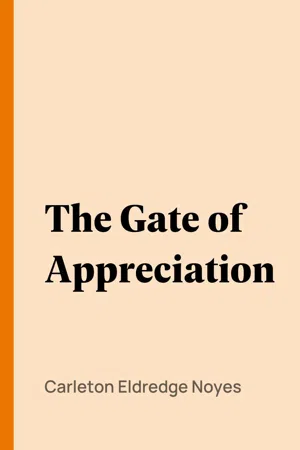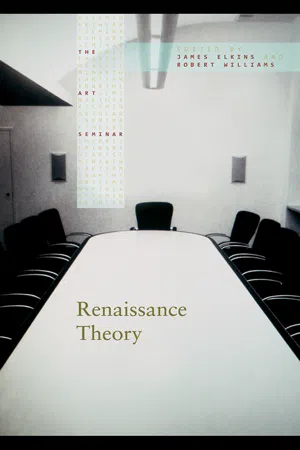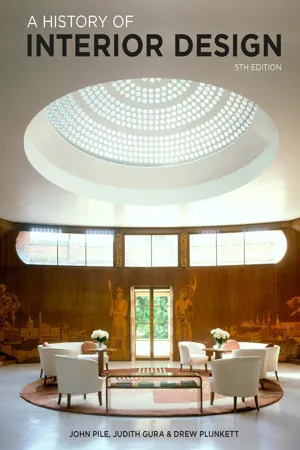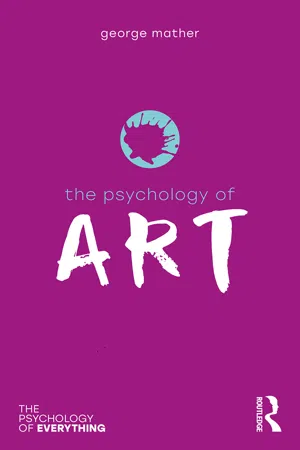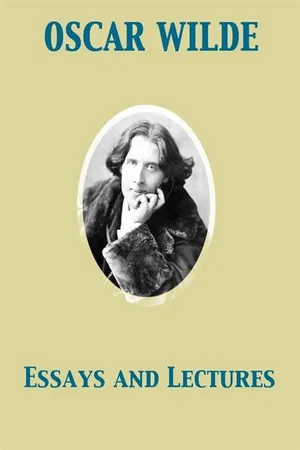History
Renaissance Art
Renaissance art refers to the period of artistic production in Europe between the 14th and 17th centuries. It is characterized by a revival of interest in classical forms, a focus on humanism, and a shift towards naturalism and perspective. Renaissance artists such as Leonardo da Vinci, Michelangelo, and Raphael created works that emphasized individual expression and the beauty of the human form.
Written by Perlego with AI-assistance
Related key terms
11 Key excerpts on "Renaissance Art"
- eBook - ePub
- Insight Guides(Author)
- 0(Publication Date)
- Insight(Publisher)
Renaissance ArtArt historians divide the Renaissance into three waves: the trecento (1300s) was the era of the workshop and fresco; the quattrocento (1400s) welcomed a new realism featuring perspective and emotion; the cinquecento (1500s), or High Renaissance, was the apogee followed by a sharp decline, as political and economic decay eventually took its toll.One of the great myths of history provides a kind of Hollywood scenario for the “birth of the Renaissance”, linking it to the fall of Constantinople in 1453, when scholars were supposed to have escaped, clutching their precious Greek manuscripts, to Italy. There, these manuscripts became a kind of magical seed, taking root, growing and bearing fruit almost immediately as “the Renaissance”.Portrait of a young man (c.1475), probably a member of the Medici dynasty, by Botticelli (Uffizi). Uffizi Florence/Dagli OrtiOf course, this is nonsense; like any other human phenomenon, the Renaissance had roots deep in history. It was the political fragmentation of Italy that created the Renaissance, each little city-state contributing something unique to the whole. But the process certainly started in Florence, and the city dominated the cultural scene until the early 16th century. Again and again over the centuries, attempts have been made to analyse the causes of the Florentine flowering, with reasons ranging from the poverty of the soil to the quality of the light. But it is no more possible to “explain” this than it is any other mystery of the human spirit.Defining the RenaissanceDetail from the Dying Slave (c. 1513), one of four “unfinished” Slaves by Michelangelo (Accademia), intended for the tomb of Pope Julius II. Getty ImagesThe very word “renaissance” is a Florentine invention. In his book Lives of the Most Excellent Architects, Painters and Sculptors - eBook - ePub
- William R. Estep(Author)
- 1986(Publication Date)
- Eerdmans(Publisher)
Chapter III Renaissance Art AND ARTISTS F or most contemporary students the mention of the Renaissance calls to mind not the literary works of the period but visions of cracked frescoes, vivid—sometimes lewd—paintings, and a variety of sculptures, mostly those of Michelangelo. For such people the epitome of the Renaissance is represented in its works of art. While it is debatable whether even the most astute art critic can learn as much about the nature of the Renaissance from a study of its art as from its literature, there is no question that its painting, sculpture, architecture, and music provide incomparable illustrations of one of the most creative eras in the history of mankind. Even though the subject matter of so many of the Italian artists’ brushes and chisels was religious, its execution on canvas or in plaster or stone was something else. For example, Michelangelo’s David, even if given another name, would still convey the glorification of the human body. It was not so much a monument to David as to mankind. At times the Renaissance Artist would lay aside all pretense of a Christian theme to create what can hardly be called anything other than a pagan production. Such is Giovanni Bellini’s The Feast of the Gods. It is difficult to imagine a more suggestive, sensual portrayal of men and women satisfying their sexual appetites with complete abandon, although Titian’s Bacchanal approaches it. The “gods” turn out to be quite human. For the most part they are neither given mythological forms nor represented stylistically. Instead the action is focused on real people, seductive women and aggressive men satisfying very human appetites. The elements characteristic of Italian painting since Giotto are present - eBook - ePub
The Parochialism of the Present
Contemporary issues in education
- G. H. Bantock(Author)
- 2017(Publication Date)
- Routledge(Publisher)
The orator played an important political role because, as we were still in an oral age, political action could be influenced by the power of persuasive speech. So the first thing to be said about the literary arts in the Renaissance is that they were directed towards very specific social and political tasks. In a developing society, made up in Italy of small principalities but, north of the Alps, of national societies which were gradually evolving out of the feudal societies of the Middle Ages, the humanist training in rhetoric in the literary arts came to play an important, central role. These societies needed lawyers and behind the legal training there was necessarily a rhetorical training in the arts of speech. They needed ambassadors and ambassadorial functions had to be fulfilled with elegance and a certain power of eloquence. They needed men able to persuade popular assemblies of citizens in the more ‘democratic’ societies, or rulers in those under the guidance of prince or king. And so this training had an important central moral and political role in the life of these societies. The literary arts were accepted as providing just such a training. Stylistically they afforded models in the work of the great classical writers like Cicero. (Latin had never died, but medieval Latin had never paid the attention to stylistic purity and eloquence which the humanist did.) Secondly, in the experience of the classical past, there was thought to be important moral guidance for the elucidation of contemporary problems. The classical experience was something which arose out of an essentially political literature, for Roman and Greek writings to a very considerable extent are oriented towards politics, a politics which was sustained by the moral philosophies of the ancients, and thus, in the range of its moral possibilities should not be confused with the politicisation of the modern totalitarian state. What indeed tended to happen in the Renaissance period was the gradual replacement of the Christian moral emphasis by a more humanistic classical emphasis derived from their literature. (That is a statement that needs to be regarded with some care because the humanists still remained primarily Christian; but by and large the classical experience now began to be absorbed and play a central role in the social and political life of the countries influenced by the humanistic revolution.)Gradually, too, the other arts — painting, sculpting, architecture — began to play an increasing cultural and social role. There was a time when such arts had been regarded as servile. The medieval painter was primarily a craftsman: the Renaissance painter, because he gradually began to theorise, and thus to lift the whole intellectual level of the work that he was doing, improved his status, until by the time we reach the high Renaissance people like Leonardo da Vinci and Michelangelo were wooed by the monarchs of Europe. (Was it not true that the Emperor Charles V himself actually bent down and picked up the paintbrush of the great artist Titian when he dropped it? What more splendid indication of the status assigned to a great artist could there be than that the Emperor himself should bend down and pick up the paintbrush of a common painter!) So, during this period artists come to improve their status enormously. From being simple craftsmen they became centrally employed in the whole business of government — as agents, one might almost say, of state prestige and propaganda. Kings and princes quarrelled, for prestige reasons, in order to get their attention. They were regarded as a means by which the state achieved fame and acclaim. So we have now a society where the arts occupied a very important and crucial role. I said earlier a ‘central’ role; perhaps it’s just as well to remember that the scholastic philosophy still continued and therefore there were those who regarded the arts with a somewhat equivocal eye for reasons that I will reveal shortly. In general, however, they now occupied a crucially important role. And indeed if one looks at the educational theory of the Renaissance one will see that at its high-water mark it recommends making a human being as if he were himself a work of art. This is the central notion of that great book of Renaissance education, Castiglione’s book The Courtier - Oscar Wilde(Author)
- 2020(Publication Date)
- Read & Co. Great Essays(Publisher)
So, in the lecture which I have the honour to deliver before you, I will not try to give you any abstract definition of beauty—any such universal formula for it as was sought for by the philosophy of the eighteenth century—still less to communicate to you that which in its essence is incommunicable, the virtue by which a particular picture or poem affects us with a unique and special joy; but rather to point out to you the general ideas which characterise the great English Renaissance of Art in this century, to discover their source, as far as that is possible, and to estimate their future as far as that is possible. I call it our English Renaissance because it is indeed a sort of new birth of the spirit of man, like the great Italian Renaissance of the fifteenth century, in its desire for a more gracious and comely way of life, its passion for physical beauty, its exclusive attention to form, its seeking for new subjects for poetry, new forms of art, new intellectual and imaginative enjoyments: and I call it our romantic movement because it is our most recent expressio n of beauty. It has been described as a mere revival of Greek modes of thought, and again as a mere revival of mediæval feeling. Rather I would say that to these forms of the human spirit it has added whatever of artistic value the intricacy and complexity and experience of modern life can give: taking from the one its clearness of vision and its sustained calm, from the other its variety of expression and the mystery of its vision- eBook - ePub
The Gate of Appreciation
Studies in the Relation of Art to Life
- Carleton Eldredge Noyes(Author)
- 2008(Publication Date)
- Perlego(Publisher)
By reference to Giotto and to Raphael I have tried to illustrate the practical application of certain principles of art study. A work of art is not absolute; both its content and its form are determined by the conditions out of which it proceeds. All judgment, therefore, must be comparative, and a work of art must be considered in its relation to its background and its conventions. Art is an interpretation of some aspect of life as the artist has felt it; and the artist is a child of his time. It is not an accident that Raphael portrayed Madonnas, serene and glorified, and Millet pictured rude peasants bent with toil. Raphael's painting is the culmination of two centuries of eager striving after the adequate expression of religious sentiment; in Millet's work the realism of his age is transfigured. As showing further how national ideals and interests may influence individual production, we may note that the characteristic art of the Italian Renaissance is painting; and Italian sculpture of the period is pictorial rather than plastic in motive and handling. Ghiberti's doors of the Florence Baptistery, in the grouping of figures and the three and four planes in perspective of the backgrounds, are essentially pictures in bronze. Conversely, in the North the characteristic art of the thirteenth and fourteenth centuries is carving and sculpture; and "the early painters represented in their pictures what they were familiar with in wood and stone; so that not only are the figures dry and hard, but in the groups they are packed one behind another, heads above heads, without really occupying space, in imitation of the method adopted in the carved relief." Some knowledge of the origin and development of a given form of technique, a knowledge to be reached through historical study, enables us to measure the degree of expressiveness of a given work. The ideas of a child may be very well worth listening to, though his range of words is limited and his sentences are crude and halting, A grown man, having acquired the trick of language, may talk fluently and say nothing. In our endeavor to understand a work of art, a poem by Chaucer or by Tennyson, a picture by Greco or by Manet, a prelude by Bach or a symphony by Brahms, we may ask, Of that which the artist wanted to say, how much could he say with the means at his disposal? With a sense of the artist's larger motive, whether religious sentiment, or a love of sheer beauty of color and form, or insight into human character, we are aided by a study of the history of technique to determine how far the artist with the language at his command was able to realize his intention. - eBook - ePub
- James Elkins, Robert Williams, James Elkins, Robert Williams(Authors)
- 2008(Publication Date)
- Routledge(Publisher)
379 Bouwsma recognized the declining relevance of “Whig history” and the foundational accounts that pictured the Renaissance as the origin of modernity. His diagnosis could equally be seen to critique the supposedly transformative moments of the French Revolution, Benjamin’s Paris, or Cold War New York. The history of art has lost much time seeking out modernity’s seed in such time/places. Why? The Cork conversation helps answer. The division of the discipline into semi-autonomous fields tends to insulate art historians from broader concerns and to stimulate competition among fields. Thus, it is necessary to argue for the relevance of Renaissance Art history, in reference to supposedly successful competitors (the art history addressing seventeenth-century Dutch art, or nineteenth-century Parisian). This is Neronian fiddling, since opinions hostile to the humanities burn close by. Instead of trying to formulate a priori specious claims for why the Renaissance deserves attention more than any other subfield, I would suggest we seek rather to invest in our disciplinary ties, reminding ourselves why the history of art is relevant today. In order to do so, we must possess a rudimentary sense of why Renaissance studies appeared to be so exemplary a field in the second-half of the twentieth century.The erstwhile dominance of Renaissance studies in the United States developed, as it seems to me, from the thirst felt for European culture at the moment of its apparent disintegration in World War II and from its apparent “systematicity,” which would seem to provide a reassuring prototype for American pragmatism. 380 A productive comparison may be drawn with the progressive strain of medieval studies that dominated the history of art’s early development in North America. With the gradual eclipse of this school of thought, associated with Charles Haskins and Joseph Strayer, whose work tended to recognize in the Middle Ages modernity’s roots, by what has been called “hard-edged alterity,” the period has come to be understood less as a point of origin than as a defining “other”. A similar process—as the portion of the Cork discussion devoted to the “irrational” in the Renaissance revealed—seems to be going on in Renaissance studies.381In Cold War America, the Renaissance came to replace the Middle Ages in progressive historical accounts, especially owing to the work of expatriate German-speaking scholars, who advanced a modernizing image of the Italian Renaissance. This, of course, is most evident in the famous work of Hans Baron, but the antitotalitarian ideology of the liberal individual (analogous to that described, in very different ways, by Karl Popper and Lionel Trilling) underpins the work of other expatriates like Paul Oskar Kristeller, Felix Gilbert, as well as Erwin Panofsky, to name but the most famous. Jettisoning the “irrational” view of the Renaissance, which emerged in the Weimar Republic and is now associated with Aby Warburg, the German-speaking émigrés offered a systematic account of a period marked by an integration of the intellectual, religious, cultural and political. 382 - eBook - ePub
- Laurie Schneider Adams(Author)
- 2019(Publication Date)
- Routledge(Publisher)
The High Renaissance in Florence and RomeThe turn of the sixteenth century in Italy evolved into the period known as the High Renaissance. It was a time of greatness in the visual arts, concentrated in a few major figures, each of whom was in one way or another engaged with the Classical revival. Donato Bramante (c. 1444 1514), whose innovations in reviving ancient forms and developing inexpensive materials laid the foundations of High Renaissance architecture in Rome, was the oldest. Leonardo and Raphael were primarily painters, although both made significant contributions to architecture. And Michelangelo considered himself a sculptor but also worked as a painter and architect and wrote poetry. Early in his career, Michelangelo was engaged with Neoplatonic philosophy, and his style reflected the Classicizing trends of the later fifteenth and early sixteenth centuries. By the end of his life, however, he had begun to develop in radically new directions. All of these artists continued the most original trends of the fifteenth century, arriving at new solutions that produced the key monuments of the High Renaissance.Michelangelo at the Turn of the Century
Michelangelo Buonarroti (1475-1564) was born on March 6 "under a . . . star," according to Vasari, his biographer and good friend. For Vasari, the celestial reference to Michelangelo's birth was more than astrological convention. It revealed his genius and heralded his future greatness. The other event of Michelangelo's childhood that has been seen as an omen of his future is the choice of his wet nurse. She was the wife of a stonecutter, and Vasari would later quote Michelangelo as having attributed "the good of [his] brain" to the pure air of Arezzo and to the "hammer and chisels" that he drank in with the milk of his wet nurse. His actual family was less fortuitous: his mother died when he was six, and his father, a minor civil servant, was unsympathetic to Michelangelo's ambition to study sculpture. - eBook - ePub
- John Pile, Judith Gura, Drew Pile(Authors)
- 2024(Publication Date)
- Laurence King Publishing(Publisher)
Furniture, textiles, and smaller artifacts that are easy to remove or replace generally survive only as museum exhibits or as antiques treasured by collectors. Fortunately, Renaissance painting turned toward increasingly realistic representation and, with the development of skill in linear perspective, artists were able to show interiors in ways that seem almost photographic. Religious subjects are usually shown set in locations of the artists’ own times, so that the kinds of scenes that appear in medieval works in conventionalized form appear in Renaissance works in ways that are almost documentary. Vittore Carpaccio (1486–1525), for example, shows St. Ursula’s dream as an event taking place in a handsomely furnished bedroom of the sort that might have been found in a Venetian or Florentine palace (6.31). The saint sleeps in a neatly made bed set on a raised platform base with painted ornamentation, with an elaborate headboard and tall posts supporting a high canopy. There is a small book cabinet and a stool pulled up to a table, and a book stand holds an open book—indications of the increasing knowledge of reading. A wall-hung candle holder suggests that lighting, using candles, must have been minimal. The door frame, window details, and moldings show Early Renaissance detail of considerable elegance. St. Augustine in his study, a favorite subject of Renaissance Artists, including Carpaccio, is often surrounded with trappings of learning, shelves filled with books, reading stands, and furniture that is often medieval in character (6.32). 6.31 Vittore Carpaccio, The Legend of St. Ursula, 1490–8. In this scene the saint sleeps in an elegant late fifteenth-century Venetian bedroom, on a bed elevated on a platform, with a high canopy supported by posts at the foot. Open windows have leaded glass above and wicker screens below, as well as shutters. 6.32 Vittore Carpaccio, St. Augustine in His Study, c - eBook - ePub
- George Mather(Author)
- 2020(Publication Date)
- Routledge(Publisher)
4DEPICTING SPACE, CONTOUR AND FORM IN ART
INTRODUCTION
From the 15th century to the 20th, the primary occupation of Western visual artists was in creating realistic depictions of the world around them, simulating a view through a window. In 1568, the Italian painter and historian Giorgio Vasari commented in his book Lives of the Artists that:Design is the imitation of the most beautiful things in nature, used for the creation of all figures whether in sculpture or painting; … the artist achieves the highest perfection of style by copying the most beautiful things in nature and combining the most perfect members, hands, torso, and legs, to produce the finest possible figure for use in all his works; this is how he achieves what we know as fine style.During the Renaissance period and for hundreds of years afterwards, artists were preoccupied with the question of how to create art that imitated nature in the most vivid and beautiful manner possible. In this quest for naturalism, they made many discoveries about human perception that often anticipated the scientific discoveries of the 19th and 20th centuries. Artists learned how to create a convincing sense of depth and space on a two-dimensional picture surface; which colour combinations are most pleasing to the spectator; how to model form and shape in paint; and how to convey dynamic action in a static image.Paul Cezanne remarked in 1904 that:being a painter, I attach myself first of all to visual sensation… . Painting by means of drawing and colour gives concrete shape to sensations and perceptions.More recently, the artist Robert Pepperell (2017) argued that artistshave tended to address the subjective aspects of human perception, i.e. the phenomenal experience of seeing the world.Psychologists since the late 1800s have had much the same aspiration as artists: to understand how we perceive three-dimensional space and shape, infer the colour of surfaces and interpret the movement of objects. Visual artists explore sensation and perception in their artistic practice of drawing, painting and sculpting, whereas scientists do so through collecting data in experimental studies. In this chapter we will consider both artistic and scientific knowledge about the visual depiction of space, contour and form. In the next chapter we will consider the depiction of colour and motion. - eBook - ePub
- Oscar Wilde(Author)
- 2010(Publication Date)
- pubOne.info(Publisher)
THE ENGLISH RENAISSANCE OF ARTAMONG the many debts which we owe to the supreme aesthetic faculty of Goethe is that he was the first to teach us to define beauty in terms the most concrete possible, to realise it, I mean, always in its special manifestations. So, in the lecture which I have the honour to deliver before you, I will not try to give you any abstract definition of beauty - any such universal formula for it as was sought for by the philosophy of the eighteenth century - still less to communicate to you that which in its essence is incommunicable, the virtue by which a particular picture or poem affects us with a unique and special joy; but rather to point out to you the general ideas which characterise the great English Renaissance of Art in this century, to discover their source, as far as that is possible, and to estimate their future as far as that is possible.I call it our English Renaissance because it is indeed a sort of new birth of the spirit of man, like the great Italian Renaissance of the fifteenth century, in its desire for a more gracious and comely way of life, its passion for physical beauty, its exclusive attention to form, its seeking for new subjects for poetry, new forms of art, new intellectual and imaginative enjoyments: and I call it our romantic movement because it is our most recent expression of beauty.It has been described as a mere revival of Greek modes of thought, and again as a mere revival of mediaeval feeling. Rather I would say that to these forms of the human spirit it has added whatever of artistic value the intricacy and complexity and experience of modern life can give: taking from the one its clearness of vision and its sustained calm, from the other its variety of expression and the mystery of its vision. For what, as Goethe said, is the study of the ancients but a return to the real world (for that is what they did); and what, said Mazzini, is mediaevalism but individuality? - eBook - ePub
- Esther (of Hampstead) Wood(Author)
- 2016(Publication Date)
- Perlego(Publisher)
The glories of the physical realm, in landscape, in the power of men and in the loveliness of women, were handled now with a growing boldness which outran the delicate timidity that had restrained it in the shadow of the Church. And with the enlargement of intellectual range there came a steady increase of technical power. The skill of choice, of selectiveness in art, of composition, draughtsmanship, colouring,—in a word, the science of expression, was brought to bear upon the ready message waiting for the perfecting of its vehicles. The adaptation of language to thought, which was the task of the fifteenth century, was achieved by the immediate predecessors of Raphael in a measure unequalled in the history of the modern world. And that such an adjustment should resolve itself, as it did, into a fresh conflict between the forces momentarily reconciled, proves, not that the success of the effort was spurious, but rather that the struggle between thought and language in art is but one manifestation of the eternal striving of the Spirit with the imperfect medium of the flesh. But this rare consummation of harmony between the erstwhile conflicting principles of classicism and romance, though reaching its highest point in Leonardo and Michaelangelo, achieved in the Venetian school a technical effect which appealed even more strongly to the æsthetic passion re-born in Rossetti and his friends, as they looked back across the ages in their search for example and light. In Giorgione, the creator of idyllic genre painting in the fourteenth century, and in Titian, of whom Rossetti himself was in due course the natural successor, they found all the mystic sensuousness of the new Paganism in a setting which, to adapt a well-worn phrase, revealed instead of concealing the soul within
Index pages curate the most relevant extracts from our library of academic textbooks. They’ve been created using an in-house natural language model (NLM), each adding context and meaning to key research topics.
